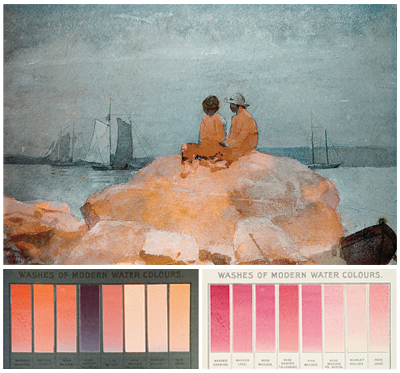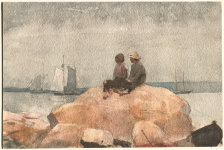UV Image: Madder lake pigment revealed
A photograph of Two Boys Watching Schooners, taken with ultraviolet light, reveals intense orange-pink fluorescence on the rocks and in the figures. Conservators commonly use ultraviolet lamps to examine works of art. Certain materials, including pigments, fluoresce under ultraviolet light—that is, they absorb ultraviolet light energy and re-emit light of a different color. The characteristic hue and intensity of fluorescence often help conservators determine the particular pigments present in an artwork.
The orange-pink fluorescence observed in Two Boys Watching Schooners suggests that Homer used madder lake, a red lake pigment that derives its color from the roots of the madder plant. Scientific analysis confirmed this identification. An ultraviolet photograph of watercolor samples from an 1887 catalog published by Winsor and Newton indicates that several of the firm’s madder pigments exhibit the same orange-pink fluorescence.
The ultraviolet photograph of Two Boys Watching Schooners shows where the artist added madder lake to the figures and rocks to convey the sun’s warmth. The contours of the fluorescence correspond precisely to the painted washes, indicating that Homer mixed the red pigment into the beige, brown, and gray tones he used to paint the boys rather than layering it under or over the figures. In the rocks, he may have applied madder pure or in a mixture.
(top) Two Boys Watching Schooners seen under ultraviolet light. This image was taken using a 254 nm light source and Kodak 2E and CC40 red filters.
(bottom) Detail of madder watercolor swatches seen under normal and ultraviolet light (left and right, respectively). From A Descriptive Handbook of Modern Water Colour Pigments (London: Winsor and Newton, 1887), pl. 2. The ultraviolet image was taken using a 254 nm light source and Kodak 2E and CC40 Red filters.


